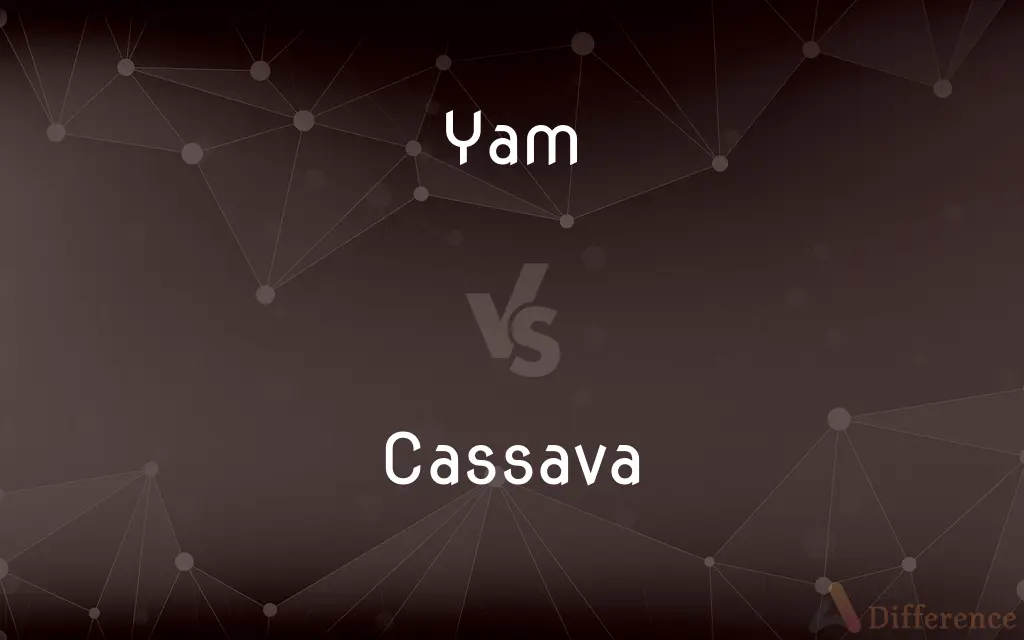Yam vs. Cassava — What's the Difference?
By Tayyaba Rehman — Updated on September 5, 2023
Yam is a tuber from the Dioscorea species, often with a brown exterior and white or purple flesh. Cassava, or manioc, is a root from the Manihot plant, with starchy white flesh.

Difference Between Yam and Cassava
Table of Contents
ADVERTISEMENT
Key Differences
Yam and Cassava are both staple foods in many countries, but they hail from different plant families. Yams come from the Dioscoreaceae family and are native to Africa and Asia. On the other hand, Cassava is from the Euphorbiaceae family and is indigenous to South America.
In terms of physical appearance, Yams are usually long and cylindrical with rough, scaly skin, varying in color from brown to pinkish. Cassava roots, on the contrary, are elongated with a brown, rough bark-like skin but are more uniform in their brown color.
Nutritionally, Yams provide good amounts of vitamin C, vitamin B6, and potassium. Cassava is particularly rich in carbohydrates, mainly in the form of dietary starch, but also provides vitamin C and calcium. It's worth noting, though, that Cassava needs proper cooking to remove naturally occurring cyanide compounds.
Culinary applications differ for Yams and Cassava. While Yams can be boiled, roasted, or fried similar to potatoes, Cassava is often processed into products like tapioca or used to make flours.
Comparison Chart
Origin
Africa and Asia
South America
ADVERTISEMENT
Plant Family
Dioscoreaceae
Euphorbiaceae
Appearance
Long, cylindrical, rough skin
Elongated, uniform brown, bark-like skin
Primary Nutrient
Vitamin C, B6, potassium
Carbohydrates (starch), vitamin C, calcium
Cooking Methods
Boiling, roasting, frying
Boiling, processing into tapioca/flour
Compare with Definitions
Yam
A starchy tuberous food from the Dioscorea species.
The yam was roasted to a golden brown.
Cassava
Often processed to make tapioca or flour.
Tapioca pearls in bubble tea are made from cassava.
Yam
A root vegetable often with brown or pinkish skin and white or purple flesh.
He added butter and spices to the boiled yam.
Cassava
A root vegetable, primarily known for its starchy content.
Cassava is a primary food source in many tropical regions.
Yam
Can be consumed in various forms - boiled, fried, or roasted.
Yam fries have become a popular snack in some restaurants.
Cassava
The plant, Manihot esculenta, native to South America.
The cassava plant thrives in tropical climates.
Yam
A staple food in many African and Asian cultures.
Yam festivals celebrate the importance of this crop in their culture.
Cassava
Must be cooked properly due to cyanogenic glycosides.
Consuming raw cassava can be harmful because of its toxins.
Yam
Not to be confused with sweet potatoes in the U.S.
She mistakenly called the yam a sweet potato at the market.
Cassava
Used in diverse dishes, from soups to breads.
Cassava bread is a gluten-free alternative loved by many.
Yam
Any of numerous chiefly tropical vines of the genus Dioscorea, many of which have edible tuberous roots.
Cassava
Manihot esculenta, commonly called cassava (), manioc, or yuca (among numerous regional names) is a woody shrub native to South America of the spurge family, Euphorbiaceae. Although a perennial plant, cassava is extensively cultivated as an annual crop in tropical and subtropical regions for its edible starchy tuberous root, a major source of carbohydrates.
Yam
The starchy root of any of these plants, used in the tropics as food.
Cassava
The starchy tuberous root of a tropical tree, used as food in tropical countries.
Yam
See sweet potato.
Cassava
The shrubby tree from which cassava is obtained, native to tropical America and cultivated throughout the tropics.
Yam
Any climbing vine of the genus Dioscorea in the Eastern and Western hemispheres, usually cultivated.
Cassava
A shrubby tropical American plant (Manihot esculenta) widely grown for its large, tuberous, starchy roots.
Yam
The edible, starchy, tuberous root of that plant, a tropical staple food.
Cassava
The root of this plant, eaten as a staple food in the tropics only after leaching and drying to remove cyanide. Cassava starch is also the source of tapioca. In both senses also called manioc, yuca.
Yam
(US) A sweet potato; a tuber from the species Ipomoea batatas.
Cassava
Manioc (Manihot esculenta), a tropical plant which is the source of tapioca.
Yam
(Scotland) Potato.
Cassava
Tapioca, a starchy pulp made with manioc roots.
Yam
(NZ) A oca; a tuber from the species Oxalis tuberosa.
Cassava
A shrubby euphorbiaceous plant of the genus Manihot, with fleshy rootstocks yielding an edible starch; - called also manioc.
Yam
Taro.
Cassava
A nutritious starch obtained from the rootstocks of the cassava plant, used as food and in making tapioca.
Yam
An orange-brown colour, like the flesh of the yam. en
Cassava
A starch made by leaching and drying the root of the cassava plant; the source of tapioca; a staple food in the tropics
Yam
A large, esculent, farinaceous tuber of various climbing plants of the genus Dioscorea; also, the plants themselves. Mostly natives of warm climates. The plants have netted-veined, petioled leaves, and pods with three broad wings. The commonest species is Dioscorea sativa, but several others are cultivated.
Cassava
Cassava root eaten as a staple food after drying and leaching; source of tapioca
Yam
Any one of several cultural varieties of the sweet potato.
Cassava
Any of several plants of the genus Manihot having fleshy roots yielding a nutritious starch
Yam
Edible tuber of any of several yams
Yam
Any of a number of tropical vines of the genus Dioscorea many having edible tuberous roots
Yam
Sweet potato with deep orange flesh that remains moist when baked
Yam
Edible tuberous root of various yam plants of the genus Dioscorea grown in the tropics world-wide for food
Common Curiosities
Where did Yams and Cassavas originate?
Yams originated in Africa/Asia; Cassava in South America.
What are Yams and Cassavas?
Yam is a tuber from Dioscorea, while Cassava is a root from Manihot.
What's a primary nutrient in Yam?
Yams are rich in vitamin C, B6, and potassium.
Are Yams and sweet potatoes the same?
No, they're different vegetables.
And in Cassava?
Cassava is rich in carbohydrates, especially starch.
Is Cassava flour gluten-free?
Yes, making it a popular choice for gluten-free recipes.
Which is more popular globally, Yam or Cassava?
Both are staples, but Cassava is more widespread due to its adaptability.
And Cassava?
Cassava can be boiled or processed into tapioca/flour.
Do Yams have a festival dedicated to them?
Yes, in some African cultures, yam festivals celebrate its significance.
Can Cassava be eaten raw?
No, it contains toxins that need cooking to neutralize.
How are Yams usually prepared?
Yams can be boiled, roasted, or fried.
Is Cassava used in beverages?
Yes, tapioca pearls in bubble tea come from Cassava.
Are there many species of Yams?
Yes, there are several species under the genus Dioscorea.
Which has a rougher skin, Yam or Cassava?
Both have rough skins, but Yams can vary more in color.
Can both be grown in the U.S.?
With the right conditions, yes, but they're more common in tropical/subtropical regions.
Share Your Discovery

Previous Comparison
Tambourine vs. Timbrel
Next Comparison
Boho vs. BohemianAuthor Spotlight
Written by
Tayyaba RehmanTayyaba Rehman is a distinguished writer, currently serving as a primary contributor to askdifference.com. As a researcher in semantics and etymology, Tayyaba's passion for the complexity of languages and their distinctions has found a perfect home on the platform. Tayyaba delves into the intricacies of language, distinguishing between commonly confused words and phrases, thereby providing clarity for readers worldwide.
















































